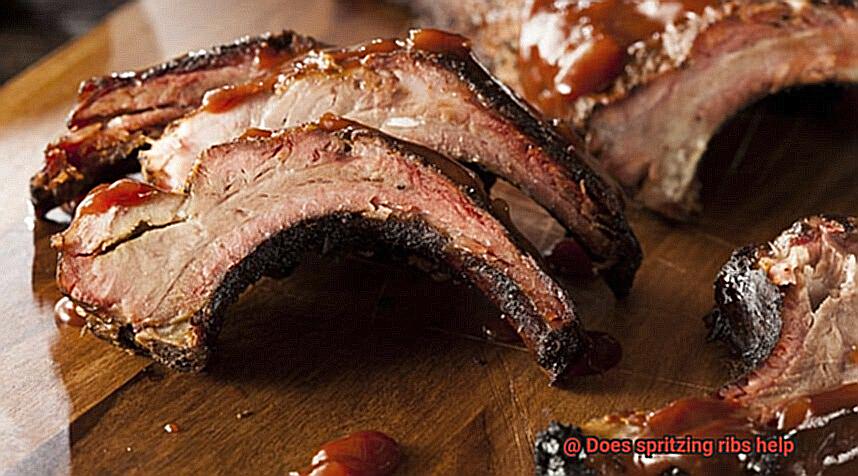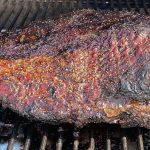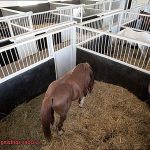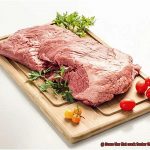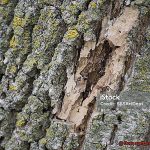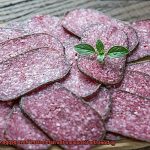Imagine this: you find yourself at a backyard barbecue, surrounded by the tantalizing aroma of sizzling ribs on the grill. Your stomach grumbles in anticipation as you eagerly await that first bite of tender, melt-in-your-mouth meat. But here’s the burning question on everyone’s minds: does spritzing ribs really make a difference?
Some BBQ aficionados swear by spritzing – the art of periodically misting or spraying the ribs during cooking – claiming it’s the secret to achieving ultimate tenderness and flavor. Others scoff at it, dismissing it as unnecessary fuss.
Join us on an epic culinary adventure as we dive into the world of rib spritzing. We’ll explore the science behind it, share expert tips, and uncover any potential pitfalls along the way. Get ready to unlock the secrets to creating mind-blowingly tender ribs that will leave your guests begging for more. Together, we’ll settle once and for all whether spritzing is a crucial step or just an old wives’ tale.
Whether you’re a seasoned pitmaster or simply love firing up your grill in the backyard, get ready to arm yourself with knowledge that will take your rib game to new heights. So let’s jump right in and uncover the truth about this age-old debate – should you spritz or not? Let’s find out.
Contents
What is Spritzing?
Whether you’re a seasoned pitmaster or just starting out, spritzing can be a game-changer when it comes to grilling or smoking meats, particularly ribs. In this article, we’ll explore the ins and outs of spritzing, from its purpose to its benefits, and provide tips on how to master this technique. So grab your apron and let’s dive in.
Why Spritzing Matters:

- Moisture is Key: Grilling or smoking ribs requires maintaining moisture. Spritzing counteracts natural moisture loss during cooking, ensuring your ribs stay juicy and tender.
- Flavor Infusion: Spritzing isn’t just about moisture; it’s an opportunity to infuse incredible flavors into your meat. Experiment with liquids like apple juice for sweetness, vinegar for tanginess, or a homemade marinade for a custom flavor blend.
- Building the Perfect Bark: Exceptional ribs have a delicious crust called the bark. Spritzing creates a moist environment that promotes the development of a flavorful crust, adding texture and taste.
Mastering the Art of Spritzing:
- Choose Your Liquid: Experiment with different liquids for flavor profiles. Try beer, fruit juices, or even a combination for a unique twist.
- Timing is Key: Start spritzing after the first hour of cooking and repeat every 30 minutes thereafter. This allows initial crust development while benefiting from moisture and flavor infusion.
- Use the Right Tools: Invest in a quality spray bottle or misting sprayer for even distribution of liquid. This prevents over-saturating one area and ensures consistent results.
- Maintain Temperature Consistency: Be mindful of temperature consistency while spritzing. Keep the lid open for as little time as possible to minimize heat loss and maintain optimal cooking conditions.
Benefits of Spritzing Ribs
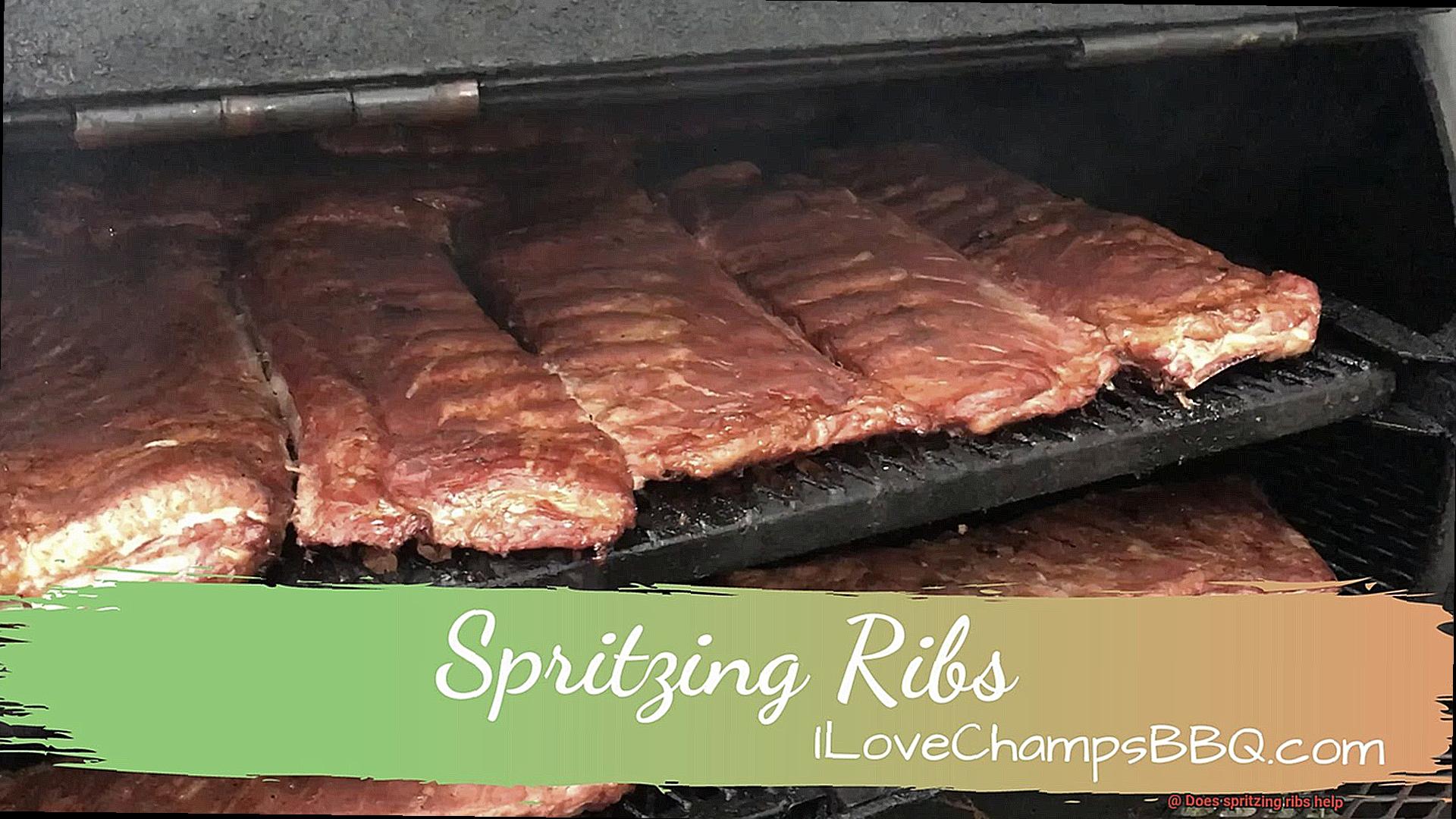
Spritzing is the secret weapon that will have your taste buds singing with delight. Spritzing your ribs while grilling or smoking is a game-changer that enhances flavor, retains moisture, tenderizes the meat, promotes bark formation, and helps regulate temperature.
First and foremost, spritzing adds an explosion of flavor to your ribs. Whether you choose apple juice, cider vinegar, or a mouthwatering marinade, the liquid penetrates the meat, infusing it with a tantalizing combination of spices and seasonings. This infusion takes your ribs from ordinary to extraordinary in a matter of sprays.
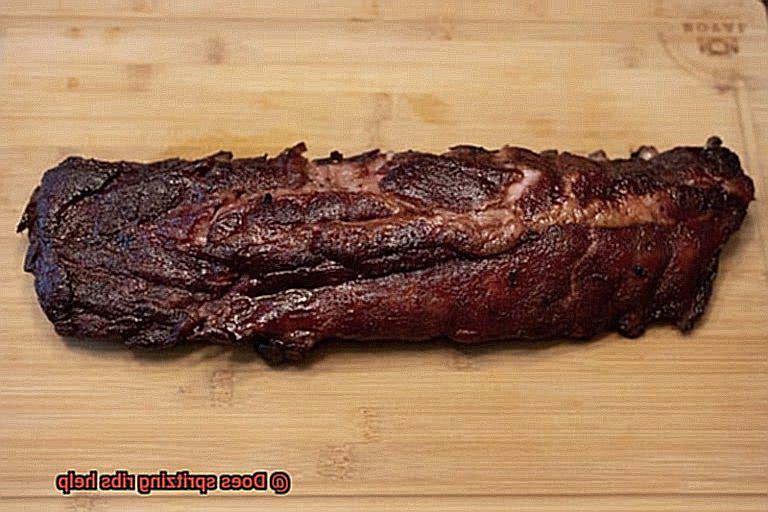
But flavor isn’t the only benefit. Spritzing also ensures that your ribs stay moist and tender throughout the cooking process. The liquid forms a protective barrier that locks in moisture, preventing those dreaded dry and tough ribs. Say goodbye to disappointment and hello to juicy perfection.
Tough cuts of ribs? No problem. Spritzing acts as a tenderizer, breaking down proteins with its natural enzymes and acids. Collagen and connective tissues don’t stand a chance against this magical mist. The result? Meat that melts in your mouth and leaves you craving more.
Let’s not forget about bark formation. Spritzing creates a thin layer on the surface of the ribs that aids in the development of that coveted caramelized crust. The texture and flavor it adds are simply irresistible. Get ready for a symphony of crispy goodness with every bite.
Lastly, spritzing helps regulate temperature during the cooking process. By momentarily cooling down the surface of the ribs, it prevents overheating and potential burning. No more hot spots or uneven cooking. Just perfectly cooked ribs from edge to edge.
Does Spritzing Help Prevent Ribs from Drying Out?
Spritzing is the secret weapon that will take your rib game to the next level. Ribs tend to dry out during the low and slow cooking process we all love. This method breaks down collagen into gelatin, resulting in tender ribs but also causing moisture loss. Enter spritzing, which creates a protective barrier that seals in moisture and prevents it from evaporating.
But what liquid should you use for spritzing? The options are endless. Apple juice or apple cider vinegar can add a tangy sweetness, while specially formulated spritzing solutions offer an explosion of flavor. Timing is crucial; aim to spritz your ribs every 30 minutes or so, adjusting as needed. Don’t drown your ribs or leave them high and dry.
While spritzing is fantastic, it’s not the only trick up your sleeve. Consider using a marinade or rub before cooking to infuse flavor and retain moisture. The “Texas crutch” method, wrapping ribs in foil during cooking, traps moisture and ensures juicy results.
How Does Spritzing Add Flavor to Ribs?
Here, we will unveil the secrets behind spritzing and how it adds an explosion of flavor to your ribs. Get ready to tantalize your taste buds and become the pitmaster extraordinaire.
The Power of Ingredients:
Spritzing is not just about adding moisture; it’s about infusing your ribs with layers of deliciousness. The choice of ingredients in your spritzing liquid is crucial. Imagine the tangy and slightly sweet taste of apple cider vinegar perfectly complementing the smoky flavor of the ribs.
The acidity in vinegar acts as a tenderizer, breaking down proteins to create melt-in-your-mouth goodness. And don’t forget about apple juice or other fruit juices that add a touch of sweetness, balancing out the savory flavors. These carefully selected ingredients work harmoniously to create a symphony of flavors.
Creating Flavorful Layers:
Spritzing is like painting a masterpiece, layer by layer. As you apply the spritzing liquid to the ribs, it interacts with any rub or seasoning previously applied, intensifying and distributing flavors evenly throughout the meat.
It’s like an orchestra where each ingredient plays its part to perfection, creating a flavor explosion in every bite. Picture the smoky spice of your favorite rub mingling with the tangy vinegar and sweet fruit juices, dancing on your palate like a symphony of taste.
Moisture Retention:
Say goodbye to dry and lackluster ribs. When meat cooks, moisture loss is a major concern. But fear not, for spritzing comes to the rescue. By regularly misting your ribs with a flavorful liquid, you create a barrier on the surface that prevents rapid evaporation. The result? Juicy, mouthwatering ribs that will leave your guests begging for more.
Imagine sinking your teeth into a succulent rib, its juices bursting forth with every bite, thanks to the magic of spritzing.
The Art of Texture:
Spritzing not only enhances flavor but also creates an irresistible texture on the surface of your ribs. As the liquid evaporates during cooking, it leaves behind a thin layer of flavor-packed residue. This magical residue caramelizes, forming a delectable crust or bark that adds both flavor and visual appeal. Imagine a perfectly caramelized crust with a hint of sweetness, giving way to tender and juicy meat beneath. It’s a symphony of textures that will have you savoring every mouthful.
Remember, It’s a Journey:
While spritzing is a powerful ally in your quest for amazing ribs, it’s important to remember that it’s just one piece of the puzzle. The quality of the meat, proper seasoning, cooking temperature, and timing all play vital roles in achieving rib perfection. Spritzing should be used in conjunction with other grilling techniques to unlock the full potential of your ribs. Consider it your secret weapon on this epic culinary adventure.
Does Spritzing Create a Caramelized Crust on the Outside of the Meat?
Spritzing, the act of spraying or misting liquid onto the surface of meat during the cooking process, has long been a popular technique among grillers. It helps keep the meat moist and enhances its flavor. But can it also help create that coveted caramelized crust on the outside of the meat? Well, the answer is not a simple yes or no – it depends on a few factors.
The key to achieving a caramelized crust on meat is the Maillard reaction. This chemical reaction occurs when heat causes amino acids and sugars in the meat to react, resulting in a browned and flavorful exterior. Spritzing with certain liquids, such as fruit juices or marinades, can contribute to this reaction by providing additional sugars and flavors to react with the heat. So, in theory, spritzing could help create a caramelized crust.
However, it’s important to note that spritzing alone may not be enough to achieve the desired result. Factors such as cooking temperature, duration, and the type of meat also play significant roles in caramelization. High heat is essential for the Maillard reaction to occur, so ensure your grill is properly preheated. The type of meat you’re cooking also matters because different meats have different levels of sugars and amino acids, which can affect how easily they caramelize.
To maximize your chances of achieving a caramelized crust through spritzing, consider the following tips:
- Choose the right spritzing liquid: Opt for liquids that are high in sugar content, such as fruit juices or sweet marinades. These will provide additional sugars for the Maillard reaction.
- Spritz at the right time: Start spritzing about halfway through the cooking process when the meat’s surface has begun to dry out. This will ensure that the liquid has an opportunity to react with the heat and contribute to caramelization.
- Experiment with different techniques: Try spritzing at different intervals or using different spritzing liquids to see what works best for your desired outcome.
- Don’t rely solely on spritzing: While spritzing can contribute to caramelization, it’s important to remember that it is just one piece of the puzzle. Factors such as cooking temperature, duration, and the type of meat also play significant roles. Consider combining spritzing with other techniques, such as dry rubs or basting with sauces, to enhance flavor and achieve a caramelized crust.
Is Spritzing Necessary for Every Cooking Method?
The question at hand is whether spritzing is necessary for every cooking method when it comes to preparing mouthwatering ribs. Let’s delve into this delicious dilemma and find some answers.
First and foremost, it’s crucial to consider the cooking method itself. When grilling ribs, spritzing can be a game-changer. The direct heat can quickly dry out the meat, leaving you with tough and flavorless ribs. However, by spritzing your ribs with a liquid like apple juice or vinegar, you can maintain moisture and prevent them from turning into a Sahara desert.
But what about other methods like smoking or slow roasting? Well, my friends, spritzing might not be as essential in these cases. These low and slow methods allow the natural juices of the meat to slowly render and keep it moist throughout the cooking process. The need for spritzing diminishes as the meat self-bastes, resulting in tender and succulent ribs.
Of course, personal preference also plays a significant role in the spritzing conundrum. Some folks swear by spritzing for that extra burst of flavor and moisture, regardless of the cooking method. It can create a beautiful glaze on your ribs or infuse them with different flavors depending on what liquid you choose to spritz with. It’s like giving your ribs a spa treatment.
On the other hand, there are those purists who believe that spritzing interferes with the natural flavors of the meat. They argue that true rib perfection doesn’t require constant spraying and that the meat should be allowed to develop its own unique taste without any meddling.
Ultimately, whether you choose to spritz or not depends on your personal preferences and desired outcomes. Experiment with different techniques and find what works best for you. Some may find that spritzing enhances their cooking experience and results in juicier and more flavorful ribs, while others may prefer a more traditional approach.
Pros and Cons of Spritzing Ribs
Look no further than the age-old debate of whether or not to spritz your ribs during the cooking process. Spritzing, or periodically spraying or misting your ribs with a liquid, has been a hot topic among grill masters for years. Let’s dive into the pros and cons of spritzing ribs and see if it’s a technique worth incorporating into your grilling repertoire.
First up, let’s talk about the pros. One of the main advantages of spritzing ribs is that it keeps them moist during the cooking process. As ribs cook on the grill or in the smoker, they can easily dry out, resulting in a tough and dry end product. But with spritzing, you can combat this by adding moisture back into the ribs, resulting in a more tender and flavorful finished product. Say goodbye to dry ribs.
But wait, there’s more. Spritzing also contributes to the development of a desirable bark on the ribs. The liquid applied during spritzing helps dissolve and redistribute the spices and rubs that have been applied to the ribs, creating a more even and flavorful crust on the outside. This bark adds texture and enhances the overall taste experience when you sink your teeth into those succulent ribs. It’s like a flavor explosion in your mouth.
Not only does spritzing keep your ribs moist and create a tantalizing crust, but it also allows you to add additional layers of flavor. Get creative and incorporate different ingredients into your spritzing liquid, such as fruit juices, honey, or Worcestershire sauce, to enhance the taste profile of the meat. These extra flavors penetrate the surface of the ribs during cooking, resulting in a more complex and delicious final product. It’s like giving your taste buds a rollercoaster ride.
Now let’s address the cons. One potential drawback of spritzing ribs is the loss of heat within the cooking environment. Each time you lift the lid or spray your ribs, heat escapes from the grill or smoker. This can prolong the cooking time, making it more challenging to achieve perfectly cooked ribs within a desired timeframe. So if you’re in a hurry or have hungry guests waiting, spritzing might not be the best option.
Another consideration is that spritzing may not be necessary for certain cuts of ribs or cooking methods. If you’re using a particularly fatty cut of ribs or cooking them low and slow in a smoker with a water pan, the added moisture from spritzing may not be needed. In these cases, spritzing may not provide any significant benefit and could potentially disrupt the cooking process. It’s all about finding the right balance.
Lastly, some individuals may find the spritzing process to be time-consuming or inconvenient. It requires regular attention and can interrupt the cooking flow. For those who prefer a more hands-off approach to grilling or smoking, spritzing may not be worth the extra effort. But if you’re willing to put in a little extra work for tender and flavorful ribs, it’s definitely worth a try.
BJCVqBBrKcE” >
Conclusion
The great rib spritzing debate has finally been settled – spritzing ribs absolutely makes a difference. It’s not just some mundane task of adding moisture; it’s an art form that elevates flavor, locks in juiciness, tenderizes the meat, encourages the formation of a delectable bark, and even helps with temperature control.
Prepare to embark on a flavor explosion as you spritz your ribs with tantalizing liquids like apple juice or vinegar. Each spritz infuses the meat with a burst of deliciousness that will leave your taste buds dancing. No more dry and tough ribs here – spritzing ensures that every bite is moist, tender, and bursting with succulence. It’s like a magic potion that transforms ordinary ribs into culinary masterpieces.
Spritzing also acts as a tenderizer, unleashing its natural enzymes and acids to break down proteins and make the meat even more tender and melt-in-your-mouth. As if that wasn’t enough, it creates a thin layer on the surface known as the bark – a flavorful crust that adds texture and complexity to each bite. Imagine sinking your teeth into perfectly cooked ribs with a crispy outer layer giving way to juicy meat underneath. It’s pure bliss.
While spritzing may not be essential for every cooking method, it truly shines when grilling or smoking ribs. The direct heat can be relentless, threatening to suck all the moisture out of your precious ribs. But fear not. Spritzing comes to the rescue by maintaining moisture levels and ensuring your ribs stay juicy throughout the cooking process. Say goodbye to bland and dry barbecue disasters.
Incorporating spritzing into your rib-cooking routine requires finesse. Choose your liquid wisely – apple juice for sweetness or vinegar for tanginess? Time your spritzes just right to maximize flavor infusion without disrupting the cooking process. And don’t forget about the tools – invest in quality spritzing equipment for even distribution and professional results. Oh, and maintaining a consistent temperature is key too – no room for fluctuation here.
So whether you’re a seasoned pitmaster with years of grilling expertise or a novice just starting your smoky journey, never underestimate the power of spritzing. It’s your secret weapon to transform ordinary ribs into extraordinary culinary delights.

